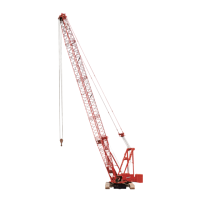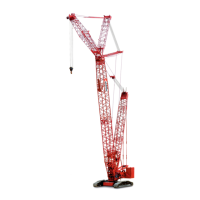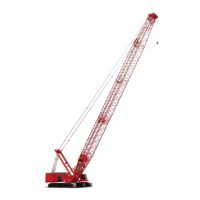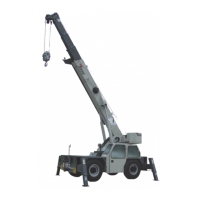SAFETY INFORMATION 999 LUFFING JIB OPERATOR MANUAL
2-12
Published 05-15-17, Control # 043-09
operation (simultaneous operation, same or opposite
direction, or individual operation).
9. When using tandem drums, the maximum operating
layers may be limited depending on whether the crane
was initially designed for tandem drum operation or not.
10. Load shift when lifting with two hooks may be more
unpredictable than typical one hook lifting.
Holding Load
When a load is suspended, the operator shall take the
following precautions:
1. Not leave his/her position at the controls
2. Not allow personnel to stand or pass under the load
3. Move all controls to off, apply all drum brakes, engage
the boom hoist pawl, and apply the swing and travel
brakes or locks.
SIGNALS
1. Continuous communication must be maintained
between the operator and the signal person during all
crane movements. If communication is disrupted,
operator shall stop all crane movements.
2. Signals to the operator must be in accordance with the
standard signals shown in Section 3, unless
communications equipment (telephone, radio, etc.) is
used.
3. All signals must be easily understood by the operator at
all times. The operator shall not respond to any signal
which is not clearly understood.
4. For operations not covered in the standard signals, or for
special situations or emergencies, additional signals
may be required. In those cases, the signals used must
be agreed upon in advance by the operator and the
signal person. The signals used must not conflict with or
have potential to be confused with the standard signals.
5. When it is necessary to give instructions to the operator
(other than those established by the signal system), all
crane motions must be stopped.
6. The signal person shall:
a. Be tested by a designated person and show that he
or she has a basic understanding of crane
operations and limitations, to include boom
deflection.
b. Be thoroughly familiar with the standard hand
signals and voice signals if used.
c. Be positioned in clear view of the operator. The
signal person’s position should give him or her a
clear view of the load, the crane, and the operating
area.
d. Direct the load so it does not pass over personnel.
e. Keep unnecessary personnel out of the crane’s
operating area.
7. When moving the crane, the following audible signals
must be used:
a. STOP - one short audible signal
b. GO AHEAD - two short audible signals
c. BACK UP - three short audible signals
SAFETY DEVICES
Manitowoc provides the following safety devices on its
cranes:
1. Horn activated by a switch on the control console in the
operator’s cab
If the horn is not working properly, it must be tagged-out
or removed, if possible.
2. Crane level indicator: either electronic (viewable in
crane’s electronic display) or mechanical (viewable from
operator’s cab seat). If the crane level indicator is not
working properly, it must be tagged-out or removed, if
possible.
3. Cranes operating on a barge require: a trim indicator, a
swing brake, and a wind direction indicator if the wind is
a factor (supplied by crane owner or user).
4. Boom stops, both physical and automatic
If a boom stop is damaged or not working properly, it
must be tagged-out or removed if possible.
WARNING
Do not operate crane unless all safety devices listed in
this section are in proper working order.
• If a safety device stops working properly during
operation, the operator shall safely stop operation.
• If any safety device listed in this section is not in
proper working order, the safety device must be taken
out of service and crane operation must not resume
until the safety device is again working properly.
• Alternative measures are not permitted to be used for
a faulty safety device.
• Always tag-out any faulty safety device and place a
warning tag in the cab stating that the crane is out of
service and must not be used.
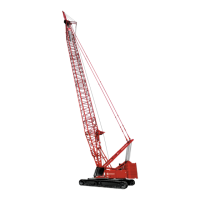
